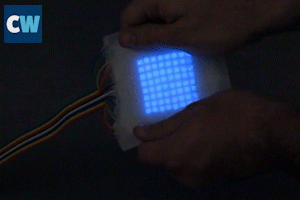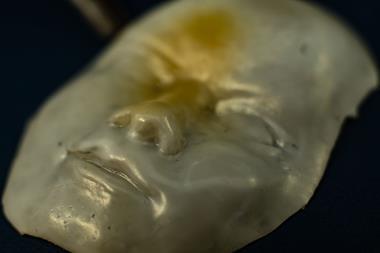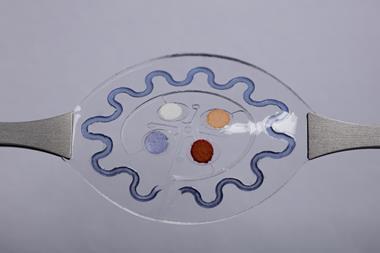Material can stretch to nearly five times its original length and emit different colours

A material that can emit different coloured light and sense touch – yet still stretch nearly five times its original length – has been invented by scientists in the US and Italy. The unique stretchiness is made possible by a transparent electrode made of a polymer swelled in salt water, and could herald a new direction in soft robotics.
‘The work is really delightful,’ says John Rogers, a materials scientist at the University of Illinois at Urbana–Champaign in the US who was not involved with the research. ‘This type of technology could be important not only as soft skins for robots, but also as indicator lighting on thin “epidermal” electronic systems of the type that are rapidly emerging as next-generation wearables.’
Recent years have seen various advances in flexible and stretchable colour-changing materials, from organic light-emitting diodes to microfluidic networks filled with dyes. Likewise, scientists have attempted to make touch sensitive ‘skins’ by, for example, coating arrays of electronic components with rubber membranes, or creating them from inherently elastic and conductive hydrogels. Few researchers have managed to combine light emission and touch sensitivity, however, particularly while retaining any useful degree of stretchiness.
That matters in the field of soft robotics, which attempts to make more biologically inspired machines for healthcare, manufacturing, domestic chores and other applications. ‘Soft robots are somewhat of a nebulous entity at the moment; they are not equipped with hardware that gives them the ability to think, sense and compute in the same way that traditional robots do,’ says engineer Chris Larson of Cornell University in Ithaca, US. ‘Our lab is one of several that is trying to equip these soft robotic systems with electronics that will allow them to do things like sense their environment, and sense their own physical state.’
Salty solution
Larson and colleagues – who are based at Cornell and the Italian Institute of Technology in Pontedera – based their material on the concept of a light emitting capacitor, a well-established technology that is used for night lights, instrument illumination and street signs. Such a capacitor has an internal dielectric containing a phosphor, which glows upon exposure to the capacitor’s electric field. In the researchers’ device, the phosphor is zinc sulfide doped with varying concentrations of copper or magnesium, which affect the light’s colour.

The stretchiness and touch sensitivity, however, come down to the capacitor’s novel structure. The doped zinc sulfide is embedded in silicone and sandwiched between two hydrogel electrodes, made from the polymer polyacrylamide swelled in salt water. The salt provides the electrical conductivity while the polymer is transparent and tough, allowing the device to be stretched by more than 480% of its original length. If the device is compressed by touch, the capacitance rises in proportion to the nearing of the electrodes, as does the brightness of the light emission.
To show off their material, Larson and colleagues added further pneumatic layers to make a simple worm-like robot that inches across a surface in an undulating fashion. Engineer Christoph Keplinger at the University of Colorado Boulder, US, says that the invention is a ‘superior solution’ to that normally seen in soft robotics, namely the integration of rigid electronics into soft structures. ‘This new robotic skin shows impressive performance, with the capability to simultaneously sense deformation and emit light of different colours, where brightness is proportional to the amount of deformation,’ he says.
Larson wants his and his colleagues’ research to inspire other groups to work on this type of skin. ‘Nothing is created in a vacuum, and so just as we have adapted previous work into something that is new, we hope that others can take the strategies presented in this work and create real devices,’ he says.
References
C Larson et al, Science, 2016, 351, 1071 (DOI: 10.1126/science.aac5082)












No comments yet